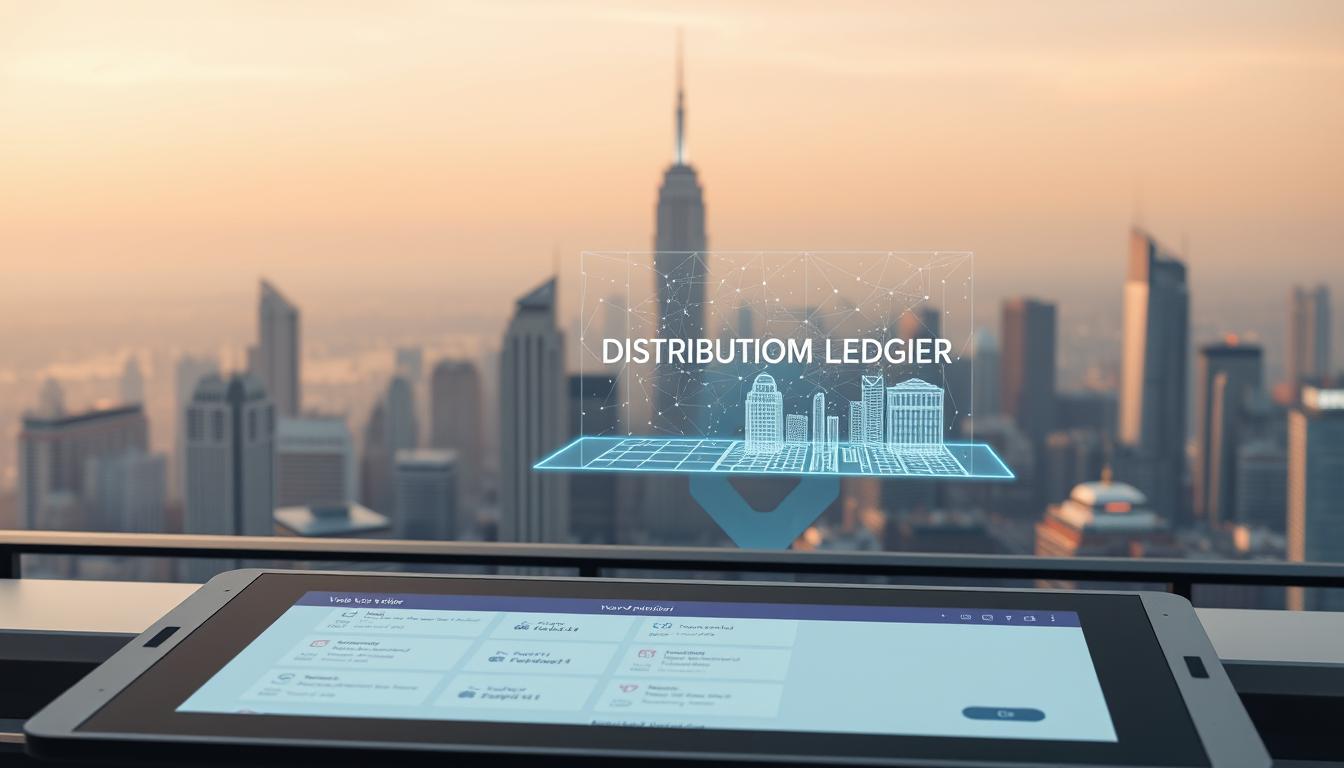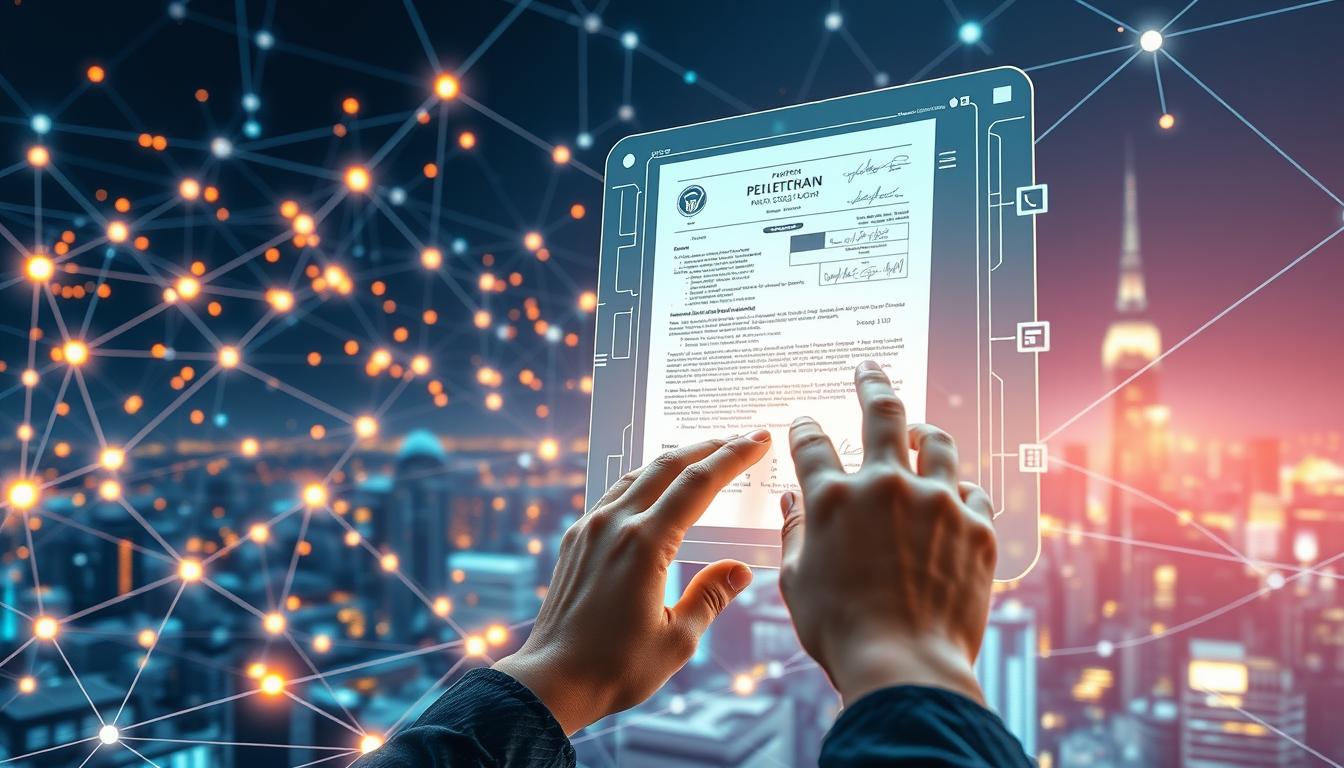Now Reading: Blockchain Voting Election Transparency Security Explained
- 01
Blockchain Voting Election Transparency Security Explained
Blockchain Voting Election Transparency Security Explained

Public faith in traditional electoral methods faces significant challenges. A global report reveals that over half of adults across 25 nations express distrust in their current electoral systems. This sentiment highlights a critical need for innovation in how we conduct democratic processes.
A technological shift is underway, offering new ways to strengthen the integrity of democratic participation. Industry surveys show that a majority of executives believe distributed ledger systems are now scalable for widespread use. This points to a future where digital innovation can address core issues of reliability.
This guide explores how advanced digital systems create a new paradigm for casting and counting ballots. We will examine how these technologies can produce permanent, verifiable records that help rebuild public confidence. The focus is on practical understanding for officials, technologists, and citizens alike.
Key Takeaways
- Widespread distrust in current electoral methods creates an urgent need for more reliable systems.
- Modern digital ledger technology is now considered mature enough for large-scale applications.
- These systems aim to create a permanent and auditable record of each participant’s choice.
- Protection against manipulation and fraud is a primary goal of these new approaches.
- Understanding this technological shift is crucial for policymakers and the public.
Introduction to Blockchain Voting and Election Transparency Security
A technological revolution is reshaping how societies approach the fundamental act of democratic participation. This innovation moves away from centralized management toward distributed, cryptographically protected methodologies.
Each participant’s choice becomes a unique, encrypted transaction within an unchangeable digital record. Once confirmed across the network, these entries cannot be modified or removed. This creates a permanent audit trail that maintains the integrity of every individual expression.
The core advantage lies in eliminating single points of failure. Traditional approaches concentrate data in vulnerable locations. Modern distributed systems spread information across multiple independent validators.
These advancements address widespread skepticism about outcome accuracy. Real-world implementations demonstrate how citizens can verify their participation while preserving anonymity. The combination of cryptographic protection and decentralized validation offers a promising path forward for democratic exercises.
The Evolution of Voting Systems with Blockchain Technology
From handwritten slips to digital tokens, the methods for recording civic choices have continuously advanced. Traditional paper-based approaches faced significant counting delays and physical vulnerabilities. Countries like India experienced these challenges firsthand, leading to the adoption of electronic voting machines in the 1990s.
Electronic machines accelerated the tallying process but introduced new concerns about digital manipulation. Each technological generation attempted to solve specific problems while often creating different vulnerabilities. This pattern of improvement and discovery characterized the entire evolution of electoral methodologies.
The emergence of cryptocurrency technologies demonstrated how distributed ledgers could maintain tamper-proof records. This breakthrough inspired innovators to apply similar principles to civic participation systems. In 2014, a pivotal white paper from Follow My Vote marked a watershed moment for practical implementation.
Modern platforms represent the culmination of lessons learned from previous system failures. They incorporate advanced cryptographic protections and distributed consensus mechanisms. Research published in the Journal of Medical Internet Research shows how digital innovations can transform traditional processes.
These contemporary approaches address speed, accuracy, and accessibility concerns more effectively than earlier technologies. The continuous refinement over the past decade has demonstrated the feasibility of next-generation voting systems.
How Blockchain Voting Enhances Election Security
The cryptographic foundation of modern voting platforms creates a new standard for electoral reliability. Each ballot becomes a unique digital fingerprint through advanced hashing techniques. This makes any alteration attempt immediately visible across the entire network.
Distributed architecture eliminates single points of failure that plague traditional methods. Electoral information spreads across multiple independent validators. Compromising the entire network would require attacking most participants simultaneously.
Once confirmed, each choice becomes permanent within the digital ledger. This immutability establishes a reliable audit trail for officials and observers. The record maintains data integrity while protecting individual privacy.
Advanced authentication measures ensure only eligible participants can access ballots. Multi-factor verification blocks 99.9% of automated attacks according to Microsoft research. Biometric checks add another layer of protection against unauthorized access.
Smart contracts automatically enforce voting rules without human intervention. They prevent common threats like duplicate submissions and result manipulation. The system requires network-wide consensus before recording any transaction.
These blockchain technology features work together to create a robust voting system. They address longstanding challenges in maintaining both transparency and confidentiality. The result is a more trustworthy framework for democratic participation.
Understanding Blockchain voting election transparency security
Digital innovation now offers unprecedented visibility into the entire voting lifecycle while protecting individual privacy. This approach creates publicly verifiable records through distributed ledger technology. Sophisticated cryptographic techniques separate voter identity from ballot content.

Transparency operates on multiple levels within these advanced platforms. The casting process becomes observable to authorized stakeholders. Real-time verification allows immediate detection of irregularities without waiting for post-election audits.
Provenance tracking creates an unbroken chain of custody for each ballot. Officials can follow choices from initial submission through validation to final tallying. This prevents manipulation while ensuring full accountability throughout the electoral process.
Enhanced visibility actually reinforces system reliability by eliminating “black box” concerns. The integrity of operations becomes visible to all participants. Consensus mechanisms require multiple validators to approve each transaction before permanent recording.
This combination addresses the fundamental trust deficit in modern democratic exercises. Citizens can verify their participation while trusting the system’s overall fairness. The methodology creates redundant verification that prevents fraudulent injections.
Technology Behind Blockchain Voting Platforms
The architecture of modern digital voting platforms is built upon a few core components that work in harmony. Understanding these elements is key to grasping how the entire system functions reliably.
- Nodes: These are individual computers spread across the network. Each one holds a full copy of the entire voting record.
- Transactions: Every single ballot cast is treated as a unique, signed transaction. It is encrypted and sent out for approval.
- Blocks: Verified ballots are grouped together into containers called blocks. Each block has a timestamp and a unique digital fingerprint.
- The Chain: Blocks are linked together in a specific order. This creates a permanent, unchangeable history of all cast votes.
Cryptographic hashing plays a vital role. It turns ballot information into a short, unique code. If any data changes, even slightly, the code becomes completely different. This makes tampering obvious to everyone on the network.
These platforms use consensus mechanisms to agree on validity. Methods like Proof of Stake ensure all nodes confirm a vote before it’s permanently recorded. This prevents any single party from manipulating the results.
Despite the complex backend, the user experience is simple. People can cast their ballots through easy-to-use web or mobile apps. The powerful distributed network handles all the verification and secure recording automatically.
The Role of Smart Contracts in Securing Elections
Self-executing code brings a new level of automation to democratic processes. These digital agreements operate without human intervention once deployed. They encode electoral rules directly into programmable logic.

Smart contracts validate participant eligibility against official registries. They prevent duplicate submissions through unique token mechanisms. This automated verification maintains system integrity throughout the entire process.
Benefits of Smart Contracts
These digital agreements accelerate result tabulation significantly. Votes get counted automatically as they are cast. This eliminates lengthy manual counting that often delays final outcomes.
The automation reduces administrative costs substantially. Traditional functions like registration verification become streamlined. Cost efficiency improves while maintaining accuracy standards.
Challenges in Smart Contract Implementation
Coding vulnerabilities present serious concerns for developers. Programming errors might create exploitable weaknesses in the system. Rigorous testing and auditing become essential before deployment.
Translating complex electoral regulations into precise code proves difficult. Legal nuances require careful interpretation by specialists. The immutability of deployed contracts adds another layer of complexity for updates.
Despite these challenges, smart contracts offer transparent execution of voting rules. They represent a significant advancement in electoral technology when properly implemented.
Voter Authentication and Privacy in Decentralized Voting
Verifying voter identity while maintaining confidentiality represents one of the most complex challenges in modern democratic systems. Without proper safeguards, unauthorized participation can undermine the entire process.
Decentralized voting platforms use sophisticated authentication methods to confirm eligibility. These systems integrate biometric recognition, government-issued digital IDs, and multi-factor verification protocols. The approach ensures only legitimate voters can access ballots.
Each verified participant receives a one-time-use digital token. This prevents double submissions that plague traditional online voting systems. The token becomes invalid after use, ensuring each person casts exactly one ballot.
Privacy protection employs advanced cryptographic techniques like zero-knowledge proofs. Voters can prove eligibility without revealing identity or choice content. Homomorphic encryption allows mathematical operations on encrypted data.
These systems separate identity verification from vote recording using cryptographic keys. The public key confirms eligibility while the private key secures the actual choice. This ensures the two data elements never connect on the public ledger.
Decentralized approaches balance electoral integrity with individual privacy. They make the process verifiable without making choices traceable. This creates a framework where security and confidentiality coexist effectively.
Benefits of Blockchain-Based Voting Systems
Digital innovation in civic participation offers significant improvements across several key areas. These modern approaches address longstanding challenges while creating new opportunities for democratic engagement.
| Feature | Traditional Systems | Modern Distributed Systems |
|---|---|---|
| Access Method | Physical polling locations only | Remote access from any location |
| Cost Structure | High printing and staffing expenses | Digital infrastructure only |
| Result Timing | Days or weeks for final counts | Real-time automated tallying |
| Participation Rate | Limited by physical barriers | Extended access increases turnout |

These platforms deliver enhanced protection through tamper-resistant architecture. The design prevents duplicate submissions and unauthorized modifications.
Remote capabilities eliminate geographical limitations entirely. Citizens with mobility challenges or overseas deployment can participate equally. This creates more inclusive democratic processes.
Financial savings become substantial with digital methodologies. Expenses for paper materials, polling stations, and temporary staff are eliminated. The approach makes civic participation more economically sustainable.
Automated recording and verification accelerate outcome reporting. Results become available within hours rather than days. This reduces periods of uncertainty that can undermine public confidence.
Extended participation windows accommodate diverse schedules. People can engage during convenient times rather than single-day limitations. This flexibility encourages broader demographic involvement.
The system creates publicly verifiable records without compromising privacy. Anyone can audit the process while individual choices remain confidential. This builds trust through observable integrity rather than blind faith.
Ensuring Data Integrity and Immutable Election Records
At the heart of trustworthy democratic processes lies the principle of permanent record-keeping. Modern systems must guarantee that once a choice is recorded, it remains unchanged throughout the entire counting process.
Cryptographic Hashing and Its Role
Advanced mathematical functions create unique digital fingerprints for each ballot. These hash values transform ballot information into fixed-length codes that serve as tamper-evident seals.
Even microscopic alterations to a single vote produce completely different hash values. This immediately reveals any tampering attempts across the entire network.
Establishing Immutable Audit Trails
The interconnected chain structure makes historical modifications practically impossible. Changing any recorded vote would require recalculating all subsequent block hashes.
This creates chronological records showing exactly when each ballot was cast and validated. Officials and observers can verify the complete process from submission to final tallying.
The distributed nature ensures thousands of independent copies exist across network nodes. This redundancy protects against both malicious tampering and accidental data corruption.
Overcoming Scalability and Performance Challenges in Online Voting
When democratic participation reaches peak levels, the underlying technology must scale accordingly. Public distributed ledgers often face transaction limits that could slow down the voting process during national events.

Bottlenecks can create delays in recording choices, potentially frustrating participants. These performance issues might undermine confidence if the system appears sluggish compared to traditional methods.
Sharding offers one effective solution by dividing the network into parallel segments. This approach distributes transaction loads across multiple validation chains.
Layer-2 protocols process votes off the main ledger before committing aggregated results. This reduces congestion while maintaining verification benefits for final outcomes.
Permissioned blockchain systems limit validator nodes to trusted authorities. They achieve faster consensus than fully public networks. Extensive testing with simulated loads identifies performance limitations before real-world deployment.
Enhancing Voter Accessibility and Transparency through Blockchain
Democracy thrives when every voice can be heard without barriers. Modern systems now remove physical and logistical obstacles that once limited participation. This creates more inclusive democratic processes where everyone can contribute equally.
Remote Voting Capabilities
Digital platforms allow citizens to cast ballots from any location with internet access. This benefits people with mobility challenges, visual impairments, or other disabilities. They can participate using assistive technologies and flexible interface designs.
Military personnel overseas and travelers during elections gain equal participation rights. Residents in isolated communities no longer face difficult journeys to polling places. Extended voting windows accommodate diverse schedules and responsibilities.
| Accessibility Feature | Traditional System Limitation | Modern Digital Solution |
|---|---|---|
| Geographical Access | Requires physical presence at specific locations | Remote participation from any internet-connected device |
| Time Flexibility | Limited to single election day hours | Extended voting periods accommodating various schedules |
| Disability Accommodation | Often requires special arrangements or assistance | Built-in assistive technologies and adaptable interfaces |
| Verification Process | Trust-based system without individual confirmation | Personal verification that each vote was recorded correctly |
Building Voter Trust through Transparency
The system creates visible trails that let people verify their participation was recorded accurately. This addresses skepticism about “black box” systems where citizens must trust authorities blindly. Individual confirmation builds confidence in the entire process.
Election observers and auditors can monitor activities in real-time. They detect irregularities immediately rather than discovering problems after results are finalized. This combination of accessibility and verification encourages broader engagement across all demographics.
Regulatory and Legal Considerations for Blockchain Voting
The intersection of established electoral laws and emerging technologies creates unique compliance challenges. Election officials must navigate complex frameworks designed for traditional methods.
Legal statutes often require physical ballot preservation and centralized oversight. These requirements conflict with decentralized digital systems. Successful implementation demands legislative updates or creative interpretations.
Data protection regulations present significant hurdles. Laws like GDPR mandate data correction or deletion rights. This clashes with the permanent nature of distributed ledger records.
| Regulatory Aspect | Traditional System Compliance | Modern System Challenge |
|---|---|---|
| Ballot Custody | Physical chain of custody protocols | Digital provenance without central control |
| Audit Requirements | Paper trail verification methods | Cryptographic verification standards |
| Recount Procedures | Manual recount processes | Digital validation mechanisms |
| Dispute Resolution | Established legal pathways | New technical arbitration needs |
Political resistance often stems from concerns about disrupting established power structures. Gaining acceptance requires demonstrating how technology enhances democratic fairness. Cross-party oversight and transparent design build institutional trust.
Certification frameworks need development for testing and validation. Election authorities require standards ensuring security and accessibility. Collaboration between developers, officials, and legal experts creates effective regulatory pathways.
Real-World Applications and Pilot Projects in Blockchain Voting
Across multiple continents, innovative digital systems are being tested in actual democratic processes. These pilots provide crucial data for election officials considering broader implementation.
| Platform/Country | Application Type | Key Features | Scale |
|---|---|---|---|
| Estonia | National Digital Governance | Integrated national ID system | Country-wide implementation |
| Voatz (US) | Military & Overseas Voting | Mobile-first, biometric authentication | Limited pilot programs |
| Follow My Vote | Open-Source Platform | Full verifiability for voters | Various organizational uses |
| Agora (Sierra Leone) | Emerging Democracy Elections | Enhanced audit capabilities | Regional pilot in 2018 |
| Polyas (Europe) | Corporate & University Votes | Enterprise-grade security | Widespread organizational adoption |
Estonia leads in national-scale digital governance. Their system incorporates distributed ledger principles for secure online participation. This approach has maintained public confidence through multiple elections.
In the United States, West Virginia and Utah conducted testing for military personnel abroad. These blockchain voting experiments addressed geographical separation challenges. The mobile platforms used advanced authentication methods.
Various blockchain-based voting solutions serve different needs. Follow My Vote emphasizes open verification for users. Voatz combines mobile convenience with robust protection measures.
Horizon State demonstrates applications beyond government elections. Their system supports corporate governance and community initiatives across Australia and Southeast Asia. These diverse implementations reveal valuable lessons about user acceptance and technical requirements.
The Sierra Leone project showed potential for emerging democracies. It provided enhanced oversight where traditional methods faced challenges. These real-world pilots inform future development of digital voting systems.
Future Innovations in Blockchain Voting and Electoral Processes
Emerging technologies are poised to revolutionize electoral processes by introducing unprecedented levels of automation and intelligence. Artificial intelligence will soon detect suspicious patterns in real-time, automatically triggering protective measures without human delays.
Biometric authentication represents another major advancement. Facial recognition and fingerprint scanning will streamline identity confirmation while enhancing protection. These solutions make participation both more secure and convenient for citizens.
Quantum-resistant cryptography development addresses future computational threats. This ensures long-term security for records against emerging quantum computer capabilities. The technology protects democratic systems for generations to come.
Decentralized identity frameworks give people control over their personal data. This enables seamless verification across different electoral jurisdictions while preserving privacy. The integration creates more flexible participation models.
Advanced privacy technologies like homomorphic encryption enable complex analyses while maintaining absolute confidentiality. These innovations support verification without compromising individual choices.
Future systems may incorporate liquid democracy models where voters delegate power to trusted representatives. This extends beyond traditional structures to create more dynamic civic engagement opportunities.
Distributed autonomous organizations could combine with electoral technology for continuous community governance. This represents the next evolution in democratic participation beyond periodic elections.
Building Trust and Confidence in Blockchain Voting Systems
Establishing public acceptance for new electoral technologies demands a multi-faceted approach. Comprehensive education campaigns help demystify the technology for average citizens. Clear explanations of protection mechanisms address common concerns about digital systems.
Confidence-building must ensure involvement from diverse stakeholders. Election officials, political parties, and technology experts should collaborate on system design. This shared ownership reduces suspicion of partisan manipulation.
Incremental implementation through small-scale pilots proves effective. Communities gain practical experience in low-stakes contexts first. This gradual approach builds evidence of reliability before major deployments.
Open-source code development enables independent security audits by researchers. Watchdog organizations can verify that systems operate as intended. This provides transparent confirmation without hidden vulnerabilities.
Rigorous testing simulates various attack scenarios to demonstrate resilience. Publicly shared results prove platforms can withstand manipulation attempts. The process must ensure accessibility across all digital literacy levels.
Sustainable trust requires ongoing transparency through regular security audits. Incident reports and performance metrics maintain accountability. This demonstrates continuous commitment to electoral integrity.
Conclusion
Modernizing how citizens engage in governance represents one of the most significant opportunities of our digital age. Distributed ledger technology offers a fundamental shift from traditional voting systems toward verifiable, decentralized approaches.
While technical and regulatory challenges remain, the potential benefits are substantial. Citizens can verify their participation while maintaining privacy throughout the electoral process. This builds confidence that every ballot is accurately recorded.
The future of democratic participation depends on collaboration between technologists, officials, and the public. When voters cast their choices through these advanced systems, they participate in a more inclusive form of democracy.
As people cast ballots with greater assurance, trust in civic institutions can be restored. This technological evolution represents more than innovation—it’s a renewal of democratic engagement for generations to come.
FAQ
How does a blockchain-based system actually improve the counting process?
It creates an unchangeable digital ledger. Once a ballot is cast, it’s encrypted and added to a chain of records. This makes the tallying process resistant to tampering and provides a clear, verifiable trail for election officials and observers.
Can these platforms protect my identity when I cast ballots?
Yes, protecting voter privacy is a key focus. Advanced cryptographic techniques, like zero-knowledge proofs, are used. These methods allow the system to confirm a vote is valid without revealing the user’s identity, ensuring confidentiality.
What happens if there is a power outage or internet failure during a remote voting session?
Robust systems are designed with redundancy. Votes are typically confirmed locally on a user’s device before being transmitted. If a connection is lost, the platform can save the data securely and complete the submission once connectivity is restored, maintaining data integrity.
Are smart contracts secure enough to manage something as critical as an electoral process?
A> Smart contracts undergo rigorous testing and auditing by cybersecurity experts before deployment. Their code is transparent and immutable, which reduces the risk of manipulation. However, continuous monitoring and updates are essential to address any newly discovered vulnerabilities.
How can the public trust that the results from a decentralized voting system are accurate?
Trust is built through verifiability. Many platforms allow voters to receive a cryptographic receipt. They can use this to independently verify that their vote was counted correctly, without knowing how others voted, which enhances overall confidence in the election results.











